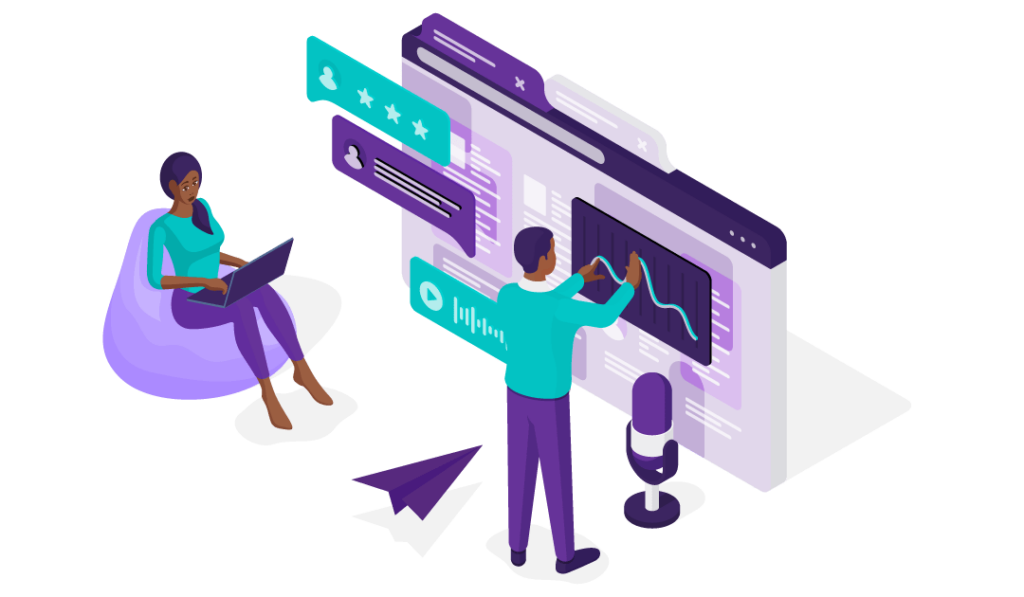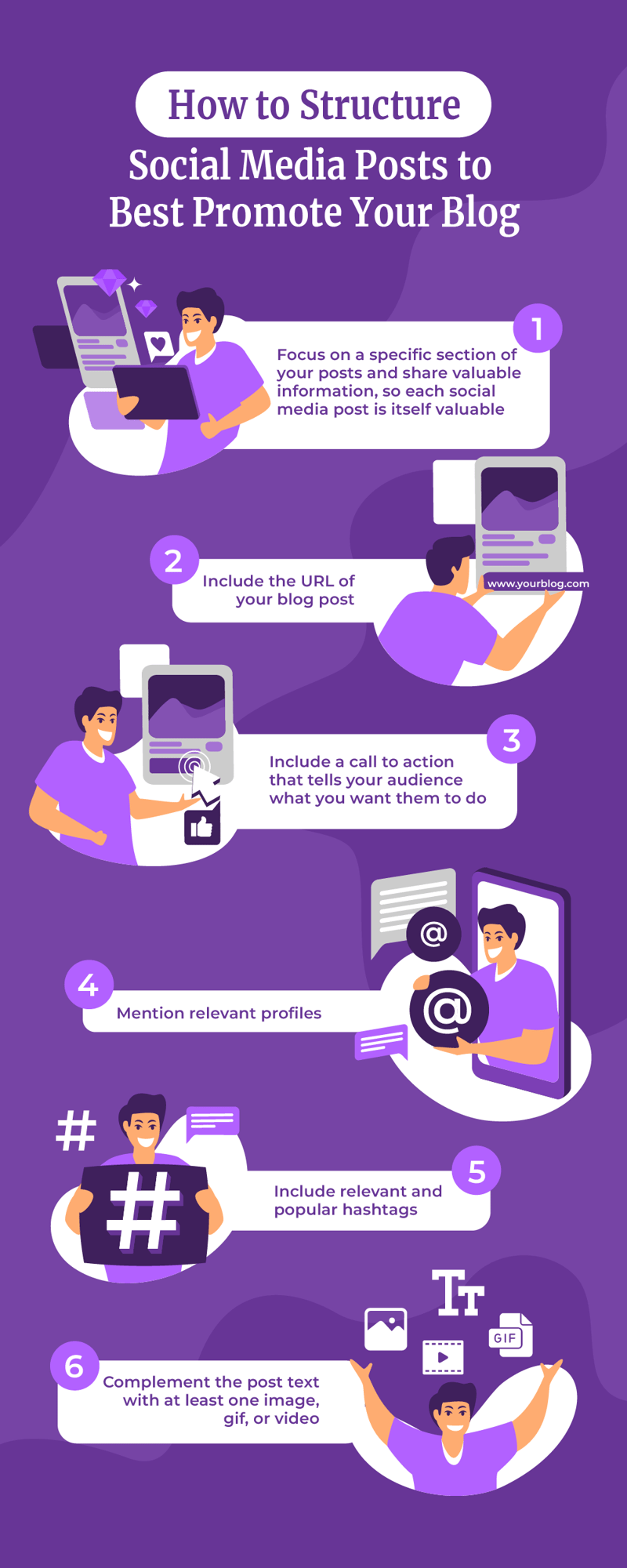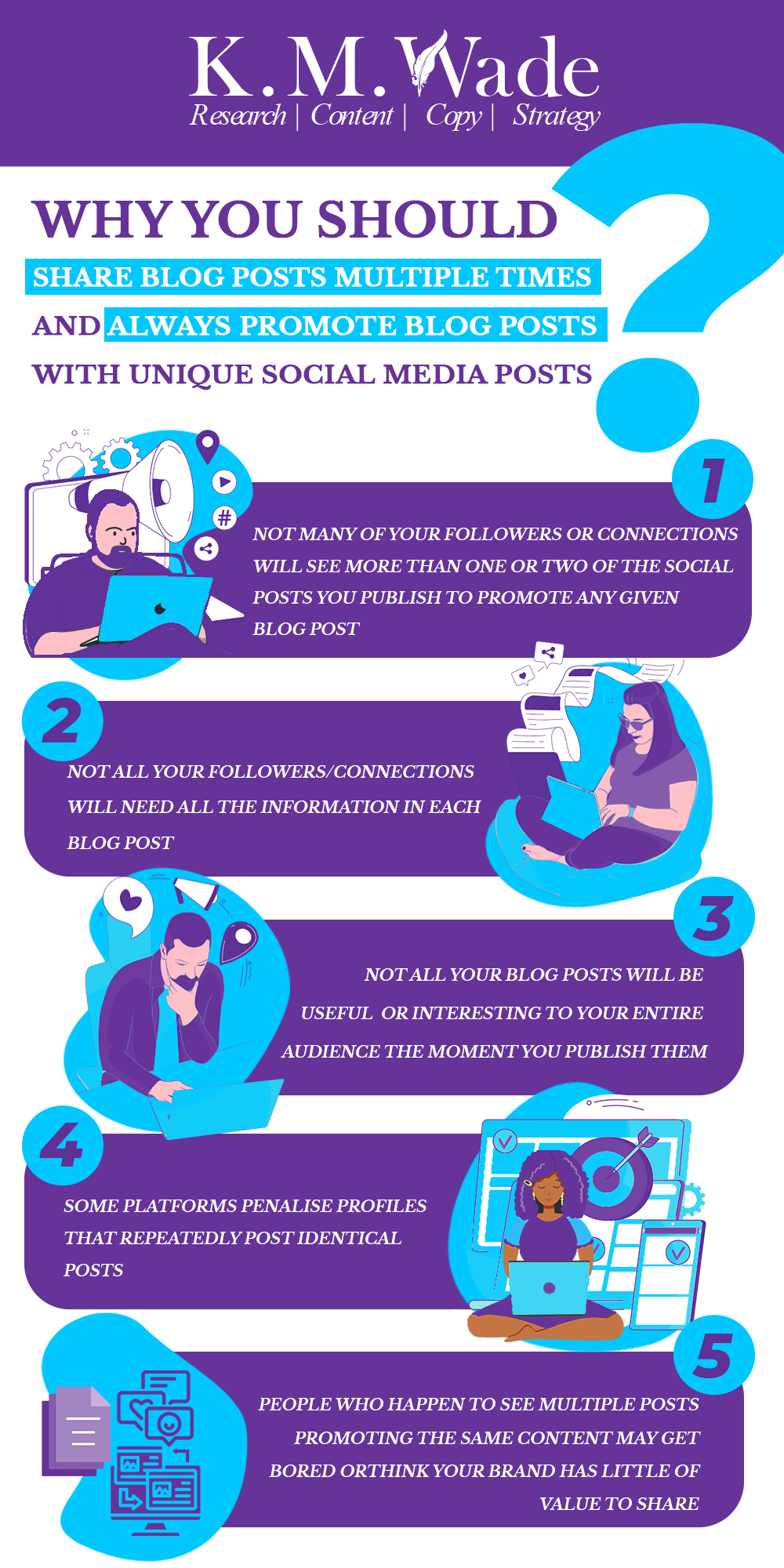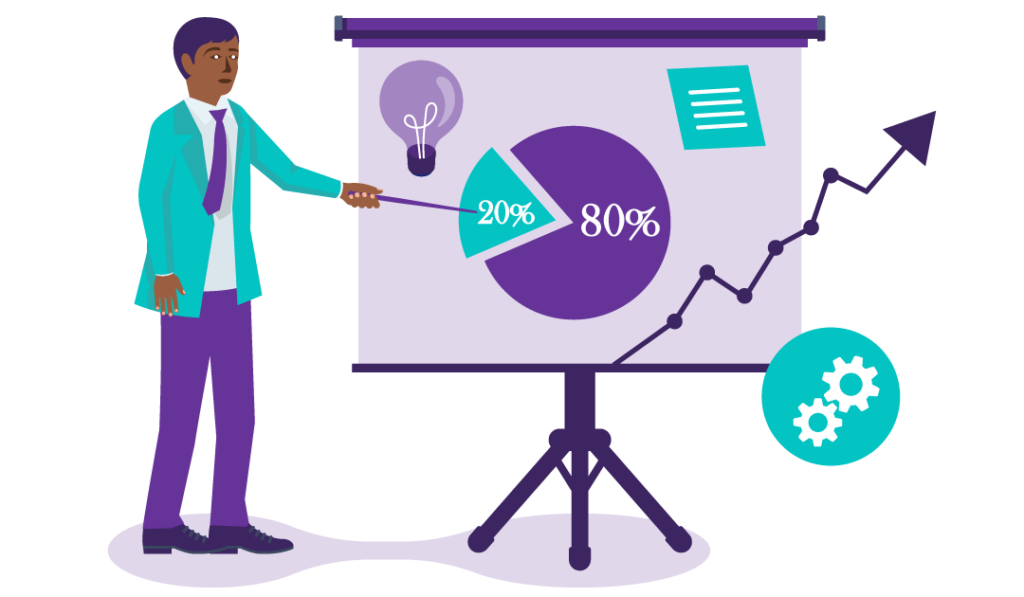There’s a wrong and a right way. Here’s how to do it effectively.
Social media is one of the most basic ways you can promote your blog. But ‘basic’ doesn’t mean ‘not effective’. If you use it the right way, social media can be a very effective way of promoting your blog to attract more visitors, increase awareness of your brand, demonstrate your expertise and ability to solve the problems your ideal customers face, ensure your customers get the most out of what they buy from you, and, ultimately, make more sales. Unfortunately, far too many businesses have no idea how to effectively promote their blog. But thankfully, you’re not going to be one of those businesses once you’ve finished this guide. You can choose to either listen to the audio or read by scrolling down.
Topics covered
How to structure your social posts when promoting your blog on social media

Ok, first things first. One of the biggest mistakes I see when people try to promote their blog on social media is that they just share a link to a particular blog post. Sometimes they’ll say something like ‘here’s our latest blog post’ or they might include the blog post title.
Why is this a mistake? Well, that approach doesn’t tell your audience why they should read your blog post. And with all the other posts competing for their attention on every social platform, your audience is highly unlikely to notice, let alone pay attention to, a post that doesn’t tell them what’s in it for them.
If you’ve done your job properly, the SEO title you specified for your blog post should give a good high-level overview of what your reader will learn. But if the title alone was enough to get people clicking on content, search engines wouldn’t need to display a description.
Similarly, if you’ve done a good job with your meta description, it should tell your target audience, in general terms at least, why they should read your blog post. But many social platforms, including Twitter and LinkedIn, don’t display the meta description when you share a link.
Apart from that, specific sections of your blog post might appeal to different aspects of your target audience. Or sections of your post might apply to your audience at different times. If you only share a high-level overview of your post, your target market might not think your content has the information they need.
For these reasons, and more, you’ll get the best results if you do more than just share a link to your blog posts when promoting them.
Here’s the best way to structure your social posts:
- Write a short summary of one piece of information you share in your blog post. Or you could pull out a short quote that does the same thing. This should provide some value to your audience even if they don’t click through to read your blog post.
- Include the URL somewhere in the post. Most people put it at the end, but there’s some evidence to suggest that putting a URL a quarter of the way through a tweet could be more effective, so there’s no reason to assume the end is the best place for a link on any platform. You might want to experiment with URL placement in your own social media posts to see what works best for your brand and audience.
- Include a call-to-action (CTA) that tells your audience what you want them to do. That could be to click through to read your blog post or it could be to like, share or comment on the social media post. Often your CTA will be at the end of your social post, but it doesn’t have to be.
- Tag, or @mention, one or more relevant profiles. (Read on for more details about this.)
- Include one or more relevant and, ideally, popular hashtags. (Read on for more details about this too.)
- Include at least one still image, gif, or video. If you’re allowing the social platform to display a ‘preview’ or ‘summary’ of your blog post, it’ll display the ‘featured image’ that’s currently selected for the post (or the image you’ve set up to display on your social card) and you don’t need to do anything else to display a visual. However, if you don’t want your social media post to display the summary or social card, or you want plenty of variety (which is always a good thing) you can remove it and insert other visuals. Either way, it’s important you include at least one visual as visuals stand out more in a user’s social feed than a plain text post will. Why is that important? Well if we take Twitter as an example, tweets with at least one image receive 150% more retweets, so you can generally reach more people on Twitter if you include at least one visual in your posts on that platform. On Facebook, posts with at least one image receive 2.3 times more engagement. And more engagement means better brand recognition and more reach.
A great way to sanity-check each social media post is to ask yourself ‘will my audience get something out of this social media post even if they don’t click through to read the blog post?’. This is because, if you want to be as successful as possible, every piece of content you publish should provide value to its intended audience — social media posts are no different. But more than that, if your audience gets something out of your social post, they may remember your brand and/or share the social post with their networks even if they haven’t read the blog post you linked to.

How often should you promote your blog on social media?

You’ll get the best results if you regularly and consistently share all your evergreen blog posts over a prolonged period of time and share any other blog posts more regularly over the time that they’re relevant.
So that means, if you write a newsjacking or ‘breaking news’ type blog post, you should put in a concerted effort to heavily promote it on social media in the hours, days, and possibly weeks after the news breaks. If you write a blog post about an upcoming event, you should regularly promote it in the lead-up to the event. And for blog posts that remain forever relevant, or at least relevant for a long time (these are your evergreen blog posts), you won’t need to promote them as heavily over the short term, but you should be regularly promoting them over the long term.
Exactly how often you promote each blog post will depend on your industry, your audience, and how often you post on social media — not to mention the platform you’re using. But as a general guide, if you’re an average social media user, a good rule of thumb is to share each blog post as soon as you publish it, two weeks later, and then at least once a month for the rest of the subsequent 12 months (so that’s 13 social media shares in the first year). On Twitter, you might post far more regularly. And if you’re a heavy social media user on other platforms, you might share your blog posts weekly. When promoting your blog on Pinterest, you’ll probably share each post once for every image within the post.
After the first year, you might promote your posts less often to make room for new posts. But more often than not, you can update older blog posts, ensuring they continue to be relevant and still rank well on Google.
I occasionally get asked why it’s important to share blog posts multiple times and why each share should be unique. There are lots of reasons, but here are some of the most important:
- Not many of your followers or connections will see each of your social media posts, so sharing multiple times improves the chance that each person will see at least one social media post promoting each blog post.
- Not all of your followers or connections will need the information in each of your blog posts the moment you publish them. By promoting each blog post over a prolonged period of time, you increase the chances that members of your audience will notice each blog post when the information is relevant to them.
- In many cases, only certain parts of a blog post will be of interest to any given member of your audience. By highlighting different aspects of your blog posts in several social media shares, you can showcase how the blog post might appeal to different parts of your audience. And you can get really clever here and share links that will take social media followers directly to the section of the blog post that you promoted in the social post.
- Another reason each social media share should be unique is to avoid annoying people who happen to see multiple posts about the same piece of content.
- Some platforms, such as Twitter, also penalise profiles that repeatedly post identical posts.

How to increase the reach of your social media posts
When you share your blog posts, you can increase your reach by ‘tagging’ other relevant users. Relevant users might be people you’ve quoted or brands whose content you’ve linked to in the blog post. Or they could be influencers in your niche who’ll find your blog post relevant and interesting. By tagging these kinds of profiles, you can encourage other brands to share (or retweet) your social posts, so they reach a wider audience.
Should you pay an influencer to share your social media posts? Well, if you can find the right influencer, this could be a very effective way to reach your exact audience. But it can be incredibly expensive. So you’ll need to weigh up the costs and benefits to see if it’s worth it for your business. In many cases, however, you won’t be able to find an influencer who has the same audience as you, so you’ll be better off paying for social media ads (see the next section).

Using appropriate hashtags on the platforms that support them is another way to help your social posts reach a wider audience. Why? Because some people search for specific information on social media, just like they do on Google, so a hashtag is a good way to get your posts in front of those people. And, more importantly, some people subscribe to or follow particular hashtags, so using the popular ones is a great way to reach profiles that don’t yet follow you.
An appropriate hashtag is one that’s relevant to the topic of your blog post and, ideally, popular with your ideal customers. You can research hashtags using a tool like best hashtags, HashtagsForLikes, or Hashtag Fox.
Another way to increase your reach on social media is to increase the size of your following. Does that mean you should buy followers? Absolutely not! Even if that ends up netting you more followers that are real people and brands (which it usually won’t) they’re not likely to be in your target market, making them useless, or even detrimental to your ability to achieve your goals.
The best ways to increase the number of people in your target market who follow you are to:
- Follow or connect with people you wish were following you — they may then follow you back (or accept your invitation to connect) and your profile may be recommended (by the platform) to their connections who may do the same
- Engage with your ideal target market on social media — like and share their posts, comment on their posts and articles and tag them on your own posts when those posts answer their questions
How to promote your blog on social media with paid ads
In addition to promoting your blog posts with unpaid social media posts, you’ve also got the option of creating paid social media ads to promote your blog and specific posts. This isn’t going to be for everyone, but it might be appropriate if you want to reach a large number of people quickly and building your audience organically isn’t getting you the results you need.
If you go down this path and you’re using your blog to win customers or clients, I highly recommend you wait until you’ve published a full content-copy funnel that links to sales content, like a landing page and/or purchase page, before you start running ads to blog posts in that funnel. If you don’t, you could send lots of ideal customers to your website without giving them clear directions as to what you want them to do once they’re there, and that’s just a wasted opportunity. Sure it’ll improve brand awareness, but you’ll get a better return on your ad investment if you only send visitors to content that has a clear call-to-action.

When you make ads to promote your blog and specific blog posts, experiment with single-image, carousel, and video ads. On platforms that allow sponsored direct messages, you could also experiment with that type of ad. The key is to make your ad stand out and deliver results with:
- A strong call-to-action that clearly directs viewers to take your desired action.
- At least one visual that grabs attention. If it can also explain why viewers should take your desired action, that’s even better.
- A heading that summarises the benefit viewers will get from taking your desired action.
- A description that spells out at least one more benefit. Your description might also demonstrate why yours is the best business to deliver the stated benefits.
Can you just ‘boost’ or ‘promote’ an existing social media post? The advice used to be ‘no’ because on some platforms there was no way to select an audience for these types of ads. But now there is. And there’s some evidence to suggest that boosted posts and ads can perform equally well when only the boosted-post features are used. Promoted posts, at least on Facebook, don’t seem to perform as well, however.
So, in general, I would recommend you experiment with boosted posts and standard ads to see what works best for your audience, content, and budget. If your ad is only relevant to particular parts of your audience that you can only target through the standard social media ads though, I’d stick with the standard ads. Otherwise, you’ll be paying to boost a post to people that won’t find it relevant.
There’s one caveat to all this. The fact that it’s so easy to boost or promote a post can lead some people to get a bit lazy, which can result in sub-optimal posts and ads that don’t give the best return on investment. So, if you choose to turn existing posts into paid ads, be sure each post is as good as possible before you pay to boost or promote it.
Other things you need to know about social media promotion
In this article I’ve only talked about how to promote your blog on social media. It’s important to realise that you can’t usually promote only your own content on a social media profile and expect to keep your followers and connections happy. If you want to make the most of your social profiles and build the best audience on each platform, you’ll benefit from also sharing curated content. Doing so helps you become the go-to source of information for your audience without having to be an expert on everything they need to know. And, as noted above, it encourages other brands to return the favour, increasing your reach.
Now curated content means different things to different people. At its most basic, curated content is any piece of content that someone else has produced. So when you retweet someone’s Twitter post or share another profile’s Facebook post, you’re sharing curated content. When you create a post around an inspirational quote, that’s also, technically, curated content, although some people don’t classify it as such if the brand puts their logo on the quote image etc.
The important thing is to share other people’s content and include your own insights — otherwise your audience could get those social posts anywhere.

How much curated content should you share? As with most things to do with marketing, the answer is ‘it depends on your brand’. For instance, creators like authors, will often be very successful if they share posts that are mostly about themselves and their work because often social media is a way for fans to learn more about their favourite authors and creators on a personal level — that’s what fans want out of their social interactions with those creators. Paulo Coehlo, bestselling author of The Alchemist, is a perfect example. Paulo’s social media strategy is all about sharing himself and his storytelling.
But this doesn’t work all that well for other brands. For instance, I’ll bet you wouldn’t follow your accountant’s social media profile just to engage with them on a personal level.
To cut a long story short, you need to experiment with different types of content, and the ratios at which you post each kind of content, to see what works best for you and your audience. However, there are some guidelines you can follow as a good starting point. (Note these guidelines don’t apply to comments where you’re directly engaging with your audience.)
The ‘Golden Ratio’

One frequently talked about guideline is the Golden Ratio. It states that 60% of a brand’s content should be curated, 30% can be original content like blog post shares, and 10% can be salesy content like new product and event announcements, and testimonials.
Service providers tend to have to reduce their salesy posts, so their ratio of post types is something like the Golden Ratio.
The 80:20 Rule

The 80:20 Rule is similar to the Golden Ratio in that it specifies that 80% of your content should be aimed at informing, educating, and entertaining your audience while the remaining 20% can be content that directly promotes your business.
B2B brands from many industries tend to need to share a significant amount of content from highly regarded experts and so the 80:20 rule often works quite well.
The 411 Rule

The 411 Rule is basically the other two combined. It states that for every promotional, salesy, self-serving post you publish, you should publish one piece of original content that’s designed to inform, educate or entertain, and four pieces of curated content.
In many cases, retail brands (whether ecommerce or not) tend to be able to get away with something close to the 411 Rule.
TLDR; How to promote your blog on social media
When promoting your blog on social media, you need to focus on:
- Capturing the attention of your ideal audience
- Clearly demonstrating why viewers should click through to read your blog post
- Providing value in each post (so your audience gets something even if they don’t visit your blog posts)
- Using profile mentions and hashtags to increase your reach
- Sharing other associated content to provide additional value and build your following, so more people see the posts that promote your blog
Next steps
Sharing your blog posts on social media is one of the most important ways you can promote your blog today. But promoting your blog will only get you so far. If your blog posts aren’t top notch, no amount of promotion is going to get you the best return on your investment in those posts (no matter whether that investment was monetary or temporal). If you want to take your blog posts to the next level, check out these articles:
